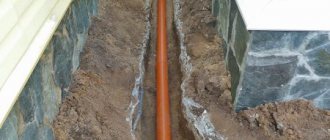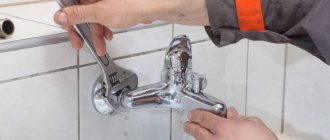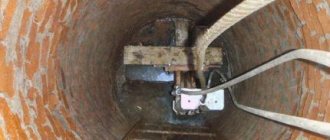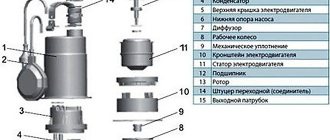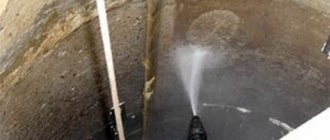An attractive and convenient way for most users is to repair a sewer pipe without dismantling it. Sometimes this method turns out to be the only method of system recovery.
Often dismantling is impossible due to expensive finishing, filling the pipes with concrete screed or placing the network in inconvenient conditions. If a hopeless blockage occurs in such an assembly, you will have to remove part of the pipe without sequentially dismantling the remaining elements. The connection principle of modern sewerage does not allow the work to be done in the usual way. You will have to use special methods, which need to be discussed separately.
Basic methods of do-it-yourself sewer repair
Common problems with the water drainage system in an apartment are blockages and leaks. Depending on the material from which the sewer system is made, a method for troubleshooting is selected.
Blockage
There are 4 ways to deal with blockages. I had the opportunity to use all 4 in practice, each copes with the task in its own way. The main thing is to correctly correlate the cleaning method and the scale of the blockage.
If your toilet or sink is draining slowly, it is wise to use the following methods. Perhaps repairs can be avoided:
- Everyone has a rubber plunger in their apartment. If used correctly, it will clear the clog quickly. Press the rubber tip firmly against the drain hole. There should be water in the sink or toilet at this moment. Perform 15–20 sharp pressures from bottom to top, making sure that the tip is firmly held on the earthenware. Then forcefully remove the plunger. The waste will rise to the surface.
- Cool boiling water will help remove fat deposits. Pour boiling water into the drain, wait 20 minutes and drain the water.
If the water does not go away, but rises up with the waste, use one of the following options:
- An effective method is chemicals to remove blockages. I used the drug "Mole", and I am pleased with the result. Other advertised products, such as "Mr. Muscle" or "Tiret", are also effective. You can pour a mixture of salt and soda into the hole, pour a glass of 70% vinegar essence, then rinse with water 2-3 times. This method will help with minor blockages. Caustic soda removes deposits on pipe walls, but this substance cannot be used for a cast iron system.
- Purchase a cable with an end from a home hardware store. The principle of operation is to twist the cable in the sewer pipe. At the same time, the brush at the end cleans the walls of plaque. While scrolling, you need to drain the water from the tank several times.
The cause of a clogged sink is the accumulation of debris in the siphon. This cannot even be called a repair: you need to unscrew the lower part of the siphon and the drain pipe, remove waste, rinse and put everything back together.
Leak
An unpleasant smell in the apartment is the first sign of a sewer leak. First you need to understand which area is leaking and promptly begin repairs. The main places are connections and joints. Leakage in these areas occurs from improper operation, installation errors and as a result of expiration of service life.
When an old cast iron pipe leaks, the entire sewer system or just the damaged area is replaced. If such repairs are beyond your means, there are other ways to fix the leak:
- process joints;
- repair a fistula or crack;
- remove the blockage.
Leaking pipes at joints
Before starting repairs, you need to warn your neighbors and ask them not to use the sewer temporarily. Clean the leak area and dry with a hairdryer. Coat with cement mortar with the addition of PVA construction adhesive. The coating dries within 24 hours. During this time, secure the leak site with a repair coupling.
Crack in cast iron and plastic pipe
For pipes made of cast iron and steel, the following methods for eliminating leaks are suitable:
- Treatment with epoxy resin or construction water-repellent adhesive.
- Wrapping with a rubber gasket and fastening with clamps.
- A bandage made of absorbent material and further impregnated with epoxy resin.
For PVC pipes use:
- cold welding;
- self-adhesive tape;
- rubber or silicone sealant.
Clogged sewer system
If sewerage is installed incorrectly in private homes, water supply pipes freeze. If a blockage has formed at this time, then under the influence of cold the blockage expands and puts pressure on the walls of the pipeline. As a result, cracks appear on the surface. The same situation is typical for apartments in Khrushchev-era buildings. For small defects, it is enough to coat the cracks with sealant.
Repairing cracks in sewer pipes
Every day the sewer riser experiences loads and pressure. The comfort of residents on all floors depends on the serviceability of this pipe in the apartment. If the riser was installed many years ago, repairs in case of severe deformation will help little; it is better to replace the damaged area completely.
For temporary fixation it will help:
- wrapping with plumbing flax;
- coating with a mixture of orthophosphoric acid and copper oxide in a ratio of 2:3;
- sealing with a solution of powdered ammonia, iron filings and sulfur.
Why are communications dehydrated before welding?
The welding method allows you to repair plastic yourself (remove defects, ensure hermetically sealed joining of elements). Soldering is carried out on a dry, clean surface. When water penetrates the welding zone, steam is generated. It creates excess pressure that breaks the plastic connection.
WATCH THE VIDEO
The need to repair a plastic pipeline will arise less frequently if the pipelines are laid and joined in accordance with the technical requirements and operating conditions. Repairing a plastic pipe requires some knowledge and a little effort.
How to repair a crack in a cast iron sewer pipe with your own hands
In order to eliminate a leak, it is necessary to accurately determine the cause of its occurrence and find the place where it is leaking. Depending on this, choose a possible repair method and carry out the work. There are several ways to fix a sewer leak. They differ in the level of reliability, the appearance of the pipe after repair and the complexity of execution.
Method 1. Installing clamps with rubber gasket
This method of repair requires access to the pipeline with a margin of at least 50 mm from the walls. This condition is very often not met, especially when the pipe in the toilet is located at an angle.
To install the clamp, it is necessary to clean the surface down to the metal using metal brushes. Then install a clamp with a rubber gasket.
Method 2. Cement bandage
This is a reliable way to repair longitudinal cracks in non-pressure pipelines. It consists of applying gauze soaked in cement mortar to the damaged area.
The area to be repaired must be thoroughly cleaned of old paint and rust. Prepare liquid cement mortar with the addition of sand in a 1:1 ratio. Immerse the gauze in the solution and ensure that it saturates the fabric well. Apply a cement bandage to the surface in several layers and tie it with a rubber bandage or copper wire.
It is recommended to cover the cement surface with liquid glass (silicate glue). This will speed up the hardening of the mixture and prevent it from washing out.
Method 3. Use of chemicals
One of the best sealants for sealing cracks and fistulas in cast iron is a mixture of phosphoric acid and copper oxide powder in a component ratio of 2:3. The prepared solution hardens very quickly and therefore it must be done before applying it to the damaged area.
Before covering the crack, the cleaned surface must be degreased with acetone or gasoline.
A solution based on orthophosphoric acid can be replaced with epoxy resin, but its hardening time is longer and after application it will require a surface wrap of dense impregnated fabric.
How to replace a sewer pipe in an apartment
When completely worn out, the damaged area must be replaced. The services of a road repair specialist, but you can install a new section yourself. If the damaged area is located under a tile or decorative panel, then opening it is necessary. Consider this as an additional cost when repairing the pipeline.
Stages of dismantling an old pipe
Before starting repairs, you need to dismantle the old pipe, turn off the water and disconnect the plumbing fixtures from the sewer. Then do the following:
- If necessary, break the cement screed and free the pipe.
- Disconnect fittings.
- Using a grinder or pipe cutter, cut off the pipe, moving 5–10 cm away from the installation site.
- Remove the sawn part with a hammer and crowbar.
- Fill potholes and uneven areas with cement mortar.
Stages of assembling a new pipeline
When replacing an old cast iron sewer system with PVC, first assemble the fittings and pipes into one system. Then marks are made on the walls, taking into account the slight slope towards the riser. Clamps are attached to the marks. After this, the installation of a new pipeline begins:
- Connect the assembled system to the sewerage inlet using a sealing collar. Make sure that no burrs appear in the cutting areas, otherwise this will cause permanent blockages.
- To connect to the plumbing equipment, the pipeline is extended to the required length.
- The tightness at the joints is checked.
Now you can use the new sewage system.
How to replace a sewer pipe in an apartment
When completely worn out, the damaged area must be replaced. The services of a road repair specialist, but you can install a new section yourself. If the damaged area is located under a tile or decorative panel, then opening it is necessary. Consider this as an additional cost when repairing the pipeline.
Stages of dismantling an old pipe
Before starting repairs, you need to dismantle the old pipe, turn off the water and disconnect the plumbing fixtures from the sewer. Then do the following:
- If necessary, break the cement screed and free the pipe.
- Disconnect fittings.
- Using a grinder or pipe cutter, cut off the pipe, moving 5–10 cm away from the installation site.
- Remove the sawn part with a hammer and crowbar.
- Fill potholes and uneven areas with cement mortar.
Stages of assembling a new pipeline
When replacing an old cast iron sewer system with PVC, first assemble the fittings and pipes into one system. Then marks are made on the walls, taking into account the slight slope towards the riser. Clamps are attached to the marks. After this, the installation of a new pipeline begins:
- Connect the assembled system to the sewerage inlet using a sealing collar. Make sure that no burrs appear in the cutting areas, otherwise this will cause permanent blockages.
- To connect to the plumbing equipment, the pipeline is extended to the required length.
- The tightness at the joints is checked.
Now you can use the new sewage system.
Replacing a sewer riser
The procedure for replacing a pipeline with your own hands includes dismantling old equipment and installing new
Please note that when changing the riser in an apartment building, it is advisable to also change the areas located in the interfloor ceiling, that is, in order to carry out repair work, you will have to negotiate with the neighbors. However, if this is not possible, only the area located in the apartment is changed
To dismantle the old cast iron riser you will need the following tools and materials:
- Angle grinder (aka grinder) or pipe cutter;
- Chisel and screwdriver for removing cut pieces and fragments;
- Hammer, nail puller (or crowbar) for loosening and removing stuck areas;
- Perforator for breaking cement;
- Polyethylene to plug the holes;
- Grinding machine for preparing a pipeline section for installation of a new pipe;
- Protective equipment (gloves, goggles or face shield) for the employee himself.
The dismantling process includes the following steps:
- First, agree with your neighbors about the need to shut off the sewer, make sure that no one is using the system;
- Initially, two horizontal cuts are made: the first 10 cm below the ceiling, the second 80 cm above the tee. The cut is made approximately half the thickness of the pipe;
- Using a hammer and chisel, hit the upper cut first, and then the lower one. The pipe should crack and be easily pulled out;
- The area located near the ceiling is covered with film. Next, you should dismantle the lower part of the sewer system with a tee;
- Try to loosen the part using a crowbar; if this does not work and the tee is securely fixed with cement mortar, in this case you should use a hammer drill. If it is not possible to remove the tee, it is simply cut off with a grinder at approximately 3 cm from the socket.
- It remains to prepare the pipeline for installation of a new section. The ends are cleaned of dirt and traces of corrosion, and then processed with a grinding machine.
Installation of a new riser
To carry out this work you will need:
- Plastic sewer pipe with a diameter of 110 mm;
- Tee;
- Rubber cuffs and expansion pipes for the transition from plastic to cast iron;
- Clamps and fasteners;
- Bubble level;
- Soap to facilitate the entry of one pipe into another.
The riser is assembled in the reverse order of dismantling, that is:
A rubber cuff is inserted into the socket of the cast iron pipe. A tee is attached to the lower part, and a special adapter is attached to the upper part. The joints are sealed with flax or special silicone
Please note that all connections must be tight, otherwise leaks are inevitable. Clamps are installed to secure the pipes. Typically, for rooms with a standard ceiling height of 2.5 meters, three mounting points are sufficient. The structure is being assembled
The compression pipe required to switch from cast iron to plastic is mounted with a tee. After this, all sections of the pipeline are connected and installed in their places. You can check the operation of the system.
Smells
Why might there be a sewer smell in the apartment? The main reason is poor ventilation of the riser. For normal operation, the sewer riser must communicate with the atmosphere; at the same time, the craving that arises in it carries away all the odors.
In the absence of ventilation, the following occurs:
- The warm air rising up the riser is forced into the upper apartments through leaky connections between the sockets of the sewer pipes and the sink drains;
- When draining the tank on one of the upper floors, the vacuum that occurs following the flow of water literally sucks the water seals out of the siphons, and wastewater evaporation begins to enter the apartment directly through the sinks.
Operating principle of a water seal.
Repairing the sewer system in an apartment when odors appear comes down to carefully sealing the connections between sink drain elbows and sewer pipes. Rubber cuffs are used for this purpose; You can temporarily seal the connection with foam rubber or tape.
The problem can be radically solved only by organizing high-quality ventilation of the riser.
The reasons for its violation may be:
- Renovation in the apartment above the riser. Apartment owners often cut off what they think is an unnecessary section of the riser above the tee. In such cases, administrative measures are taken against the author of the unauthorized change in utility lines;
- Formation on the riser above the level of the roof of the snow cap. Vapors that freeze at subzero temperatures eventually completely block the lumen of the pipe. The easiest way to melt the hat is with a bucket of hot water.
Snow cap on a sewer riser.
Repairing sewer pipes in an apartment with your own hands
A problem can arise unexpectedly in any part of the pipeline, and no one can predict where the defect will appear. In most cases, urgent repairs of sewer pipes made of cast iron (or plastic) have to be performed due to the following faults:
- The occurrence of unpleasant odors emanating from elements of the sewer network. This clearly indicates that one or another element of the system has cracked. Or there is a major blockage in it - which is also a fairly serious problem.
- The occurrence of leaks directly at the joints of elements of the sewerage system;
- Pipe blockage (complete or partial).
The last of the above malfunctions is observed in domestic sewers very, very rarely, but still sometimes you have to deal with such a disaster. Typically, blockages occur in siphons located under sinks or sinks in the kitchen. A variety of debris is likely to accumulate in pipeline assemblies, especially in kitchen ones. Any person can remove it, and without the use of any equipment - just use the familiar plunger. A few confident movements with this simple device, and the blockage will disappear in no time. The main thing is not to forget to thoroughly rinse the cleaned system with water, and under pressure.
In cases where the specific design of the sink requires the presence of a special hole that provides it with reliable protection from excessive filling, in other words, from overflow, this overflow must be closed before using the plunger. Otherwise, you will continuously drive air through the sewer pipes. There will be no result. For the simple reason that the blockage will not go away.
You can also use a plunger in cases where the toilet becomes clogged in a private house or apartment for one reason or another.
Here, however, it is important to note that the proposed solution to the problem does not always help. It is also possible that the plunger will have an effect, but not to the extent necessary
However, no matter what, it’s still worth trying to use this remedy. If the expected results are not obtained (that is, the clog that has formed remains in place), you must try to clear the toilet drain using chemical cleaning compounds. If this is also useless, then in any case you will have to use a special cable to carry out cleaning, and in some situations (for really complex blockages) you will need to call professionals “armed” with special equipment.
The quality of assembly of the sewerage system directly determines its service life. In addition, there is a high probability that sewer pipes will need to be repaired. But even the highest quality assembly will not be able to guarantee you a 100% probability of no accidents or any other urgent situations. Therefore, it makes sense to take a closer look at the basics that will make it possible to independently eliminate problems that arise with the pipes of the sewer system.
Common causes of breakdowns
The need for urgent repairs occurs in the following cases:
- The appearance of leaks at the joints of pipes.
- There is a crack in the pipe that gives off an unpleasant smell.
- There was a blockage in the pipe.
Let's look at each of the above cases in more detail.
Leakage at joints
This problem, in turn, can be of two types - a leak at the entrance to the pipe, or a leak at its junction. Depending on the level of breakdown, tactics vary somewhat.
Leak at inlet
The first step is to determine the place where the sewer pipe is leaking. The most common leaks are sinks, as well as bathroom sinks and drains. Connection defects that occur at the boundaries of the siphon and the drain hole are the most common cause. To resolve the problem, it is necessary to check the condition of the gasket and, if possible, replace it, and then tighten the connection where the leak occurs. Sometimes it may be necessary to seal the pipe entry area.
A leak that occurred at a pipe junction
If a leak occurs at the junction of pipes made of cast iron, the operation will be much more difficult than discussed above. Fixing a leak is determined by the type of connection: it may consist of lead or cement.
The sequence of necessary actions when cementing sewerage elements is as follows:
- Use a hammer and chisel to remove the old cement.
- The packing is removed along with the remains from the gap.
- A new layer of packing is laid, after which a fresh layer of sealant is hammered in. All this is sealed on top with concrete mortar. To prepare it, you need to take water and cement in a ratio of 1:10.
Professional recommendation: in order to increase the reliability of the seal, a special mixture is used to coat the sealant strands. It is obtained from asbestos and cement (proportion 3:7) and water. It is necessary to add water exactly until the existing consistency of the mixture begins to resemble plasticine.
The sequence of actions for lead connection of elements is as follows:
- It is necessary to clean the connection material until pure metal appears.
- Using a chisel, hammer in new lead cones. Due to the fact that lead is a soft metal, following such recommendations will not be difficult.
Let's consider a more complex situation - how can you seal a sewer pipe if, of all the necessary means, only cement is available, but, for one reason or another, there is no sealant? Make it real.
The algorithm of actions in this case can be characterized as follows:
- It is necessary to clean the joint, get rid of the old existing seal;
- Take a medical bandage, as well as liquid glass and cement;
- The cement solution, or rather, its desired consistency in the form of a slurry, is obtained by adding water. The importance of this consistency of the composition is explained by the need to dip the bandage into it. Correcting for the presence of liquid glass, the rate of solidification increases significantly. This means that you should work at the fastest possible pace;
- We wet the bandage in the resulting solution and carefully wrap a thick layer around the junction point of the pipes;
- After 2 hours, it is permissible to hide cosmetic imperfections by painting over the defect area with paint.
If a leak occurs at the junction of plastic pipes, the only necessary measure is to replace the rubber seal. Apply silicone sealant over the defect for greater reliability.
